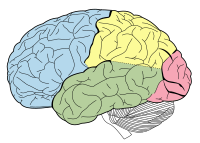
Noninvasive neurostimulation of left temporal lobe disrupts rapid talker adaptation in speech processing
Sign Up to like & getrecommendations! Published in 2019 at "Brain and Language"
DOI: 10.1016/j.bandl.2019.104655
Abstract: Talker adaptation improves speech processing efficiency by reducing possible mappings between talkers' speech acoustics and listeners' phonemic representations. We investigated the functional neuroanatomy of talker adaptation by applying noninvasive neurostimulation (high-definition transcranial direct current stimulation;… read more here.
Keywords: speech processing; speech; temporal lobe; talker ... See more keywords

Cortical mechanisms of talker normalization in fluent sentences
Sign Up to like & getrecommendations! Published in 2020 at "Brain and Language"
DOI: 10.1016/j.bandl.2019.104722
Abstract: Adjusting to the vocal characteristics of a new talker is important for speech recognition. Previous research has indicated that adjusting to talker differences is an active cognitive process that depends on attention and working memory… read more here.
Keywords: mechanisms talker; talker normalization; speech; cortical mechanisms ... See more keywords

Selecting among competing models of talker adaptation: Attention, cognition, and memory in speech processing efficiency
Sign Up to like & getrecommendations! Published in 2020 at "Cognition"
DOI: 10.1016/j.cognition.2020.104393
Abstract: Phonetic variability across talkers imposes additional processing costs during speech perception, often measured by performance decrements between single- and mixed-talker conditions. However, models differ in their predictions about whether accommodating greater phonetic variability (i.e., more… read more here.
Keywords: processing; speech processing; processing efficiency; talker ... See more keywords

Encoding and decoding of meaning through structured variability in intonational speech prosody
Sign Up to like & getrecommendations! Published in 2021 at "Cognition"
DOI: 10.1016/j.cognition.2021.104619
Abstract: Speech prosody plays an important role in communication of meaning. The cognitive and computational mechanisms supporting this communication remain to be understood, however. Prosodic cues vary across talkers and speaking conditions, creating ambiguity in the… read more here.
Keywords: prosodic cues; talker; prosody; variability ... See more keywords

How who is talking matters as much as what they say to infant language learners
Sign Up to like & getrecommendations! Published in 2018 at "Cognitive Psychology"
DOI: 10.1016/j.cogpsych.2018.04.003
Abstract: Human vocalizations contain both voice characteristics that convey who is talking and sophisticated linguistic structure. Inter-talker variation in voice characteristics is traditionally seen as posing a challenge for infant language learners, who must disregard this… read more here.
Keywords: voice; language; voice characteristics; language learners ... See more keywords

When it is apt to adapt: Flexible reasoning guides children's use of talker identity and disfluency cues.
Sign Up to like & getrecommendations! Published in 2018 at "Journal of experimental child psychology"
DOI: 10.1016/j.jecp.2017.11.008
Abstract: An eye-tracking methodology was used to examine whether children flexibly engage two voice-based cues, talker identity and disfluency, during language processing. Across two experiments, 5-year-olds (N = 58) were introduced to two characters with distinct color preferences.… read more here.
Keywords: use talker; identity disfluency; talker identity; disfluency ... See more keywords

Bilateral Cochlear Implants Allow Listeners to Benefit from Visual Information When Talker Location is Varied.
Sign Up to like & getrecommendations! Published in 2020 at "Journal of the American Academy of Audiology"
DOI: 10.1055/s-0040-1709444
Abstract: BACKGROUND Previous research has found that when the location of a talker was varied and an auditory prompt indicated the location of the talker, the addition of visual information produced a significant and large improvement… read more here.
Keywords: cis; information; location; visual information ... See more keywords

Hearing taboo words can result in early talker effects in word recognition for female listeners
Sign Up to like & getrecommendations! Published in 2018 at "Quarterly Journal of Experimental Psychology"
DOI: 10.1080/17470218.2016.1253757
Abstract: Previous spoken word recognition research using the long-term repetition-priming paradigm found performance costs for stimuli mismatching in talker identity. That is, when words were repeated across the two blocks, and the identity of the talker… read more here.
Keywords: taboo words; talker; word recognition; talker effects ... See more keywords

Talker-specific predictions during language processing
Sign Up to like & getrecommendations! Published in 2020 at "Language, Cognition and Neuroscience"
DOI: 10.1080/23273798.2019.1630654
Abstract: ABSTRACT Language comprehension is shaped by world knowledge. After hearing about “a farm animal,” meanings of typical (“cow”) versus atypical exemplars (“ox”) are more accessible, as evidenced by N400 responses. Moreover, atypical exemplars elicit a… read more here.
Keywords: atypical exemplars; language; talker specific; specific predictions ... See more keywords

Selective attention to a talker's mouth in infancy: role of audiovisual temporal synchrony and linguistic experience.
Sign Up to like & getrecommendations! Published in 2017 at "Developmental science"
DOI: 10.1111/desc.12381
Abstract: Previous studies have found that infants shift their attention from the eyes to the mouth of a talker when they enter the canonical babbling phase after 6 months of age. Here, we investigated whether this… read more here.
Keywords: mouth; synchrony linguistic; attention; talker ... See more keywords

Aging and the use of syntactic and talker consistency cues in a temporally interleaved task
Sign Up to like & getrecommendations! Published in 2017 at "Journal of the Acoustical Society of America"
DOI: 10.1121/1.4988465
Abstract: The purpose of the present study was to identify differences between older and younger listeners in how they use talker consistency and word order cues in both to-be-attended and to-be-ignored streams. A temporally-interleaved method was… read more here.
Keywords: order; talker consistency; temporally interleaved; talker ... See more keywords